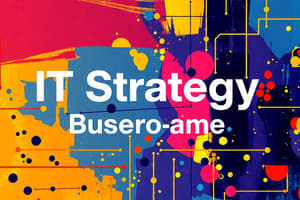Podcast
Questions and Answers
Which framework is mentioned as providing guidelines for securing information systems?
Which framework is mentioned as providing guidelines for securing information systems?
- COBIT
- CIS Controls
- ISO/IEC 27001 (correct)
- TOGAF
What is one consequence of not complying with industry-specific regulations in sectors like healthcare and finance?
What is one consequence of not complying with industry-specific regulations in sectors like healthcare and finance?
- Stronger IT governance
- Legal repercussions (correct)
- Enhanced customer trust
- Increased operational efficiency
Which governance model is best suited for organizations seeking a consistent IT approach?
Which governance model is best suited for organizations seeking a consistent IT approach?
- Hybrid IT Governance
- Decentralized IT Governance
- Autonomous IT Governance
- Centralized IT Governance (correct)
Which of the following terms includes standards for data privacy and IT management?
Which of the following terms includes standards for data privacy and IT management?
What do regulations like GDPR and CCPA primarily govern?
What do regulations like GDPR and CCPA primarily govern?
What is a primary advantage of centralized IT governance?
What is a primary advantage of centralized IT governance?
Which role is primarily responsible for strategy development within IT governance?
Which role is primarily responsible for strategy development within IT governance?
What does Enterprise Architecture (EA) primarily aim to achieve?
What does Enterprise Architecture (EA) primarily aim to achieve?
Which of the following is NOT a source of IT risks as described in Enterprise Risk Management (ERM)?
Which of the following is NOT a source of IT risks as described in Enterprise Risk Management (ERM)?
The Capability Maturity Model Integration (CMMI) is used to assess what aspect of an organization?
The Capability Maturity Model Integration (CMMI) is used to assess what aspect of an organization?
Which law requires organizations to protect personal data and maintain transparency in data practices?
Which law requires organizations to protect personal data and maintain transparency in data practices?
In a hybrid model of IT governance, which aspect is prioritized?
In a hybrid model of IT governance, which aspect is prioritized?
What is a potential drawback of decentralized IT governance?
What is a potential drawback of decentralized IT governance?
What is the primary purpose of IT governance?
What is the primary purpose of IT governance?
Which framework primarily focuses on best practices for IT service management?
Which framework primarily focuses on best practices for IT service management?
What does ISO/IEC 27001 primarily address?
What does ISO/IEC 27001 primarily address?
Which of the following is NOT a component of effective IT governance?
Which of the following is NOT a component of effective IT governance?
How does COBIT support organizations in managing IT resources?
How does COBIT support organizations in managing IT resources?
What is the role of IT policies within IT governance?
What is the role of IT policies within IT governance?
What distinguishes IT standards from IT procedures?
What distinguishes IT standards from IT procedures?
Why is alignment of IT strategy with business strategy important?
Why is alignment of IT strategy with business strategy important?
Flashcards are hidden until you start studying
Study Notes
Governance & Management of IT
- IT governance and management align technology initiatives with the organization's overall strategy.
- The framework ensures effective and efficient use of IT resources to achieve organizational goals.
1. IT Governance and IT Strategy
- IT governance provides a structure for directing and controlling the enterprise using IT resources, achieving organizational goals.
- It defines roles, responsibilities, and decision-making rights to align IT initiatives with the organization's strategy.
- IT strategy is a plan outlining how IT will be used to meet business objectives.
- Effective IT governance ensures IT strategy aligns with the overall business strategy.
- This vital alignment drives operational excellence, innovation, and competitive advantage.
2. IT-Related Frameworks
- Frameworks provide structured guidance for managing and governing IT resources.
- COBIT (Control Objectives for Information and Related Technologies) is a comprehensive framework aligning IT goals with business objectives. It helps organizations get maximum value from their IT investments.
- ITIL (Information Technology Infrastructure Library) focuses on best practices for IT service management (ITSM). It provides guidelines for delivering high-quality IT services.
- ISO/IEC 27001 sets a standard for information security management systems (ISMS), ensuring security controls protect information assets.
- TOGAF (The Open Group Architecture Framework) offers a structured approach for designing, planning, implementing, and governing enterprise architecture.
3. IT Standards, Policies, and Procedures
- IT Standards are benchmarks or criteria for consistency and quality in IT processes and systems.
- Policies are formal guidelines defining how IT resources should be managed, covering security, data management, compliance, and IT asset usage.
- Procedures are step-by-step instructions implementing IT policies and standards, including incident management, change management, and software deployment.
4. Organizational Structure
- Organizational structure for IT governance depends on size, industry, and strategic priorities.
- Centralized IT Governance involves a single central department overseeing all IT activities for uniformity and streamlined decision-making.
- Decentralized IT Governance allows each business unit or department to manage its own IT resources for flexibility and closer alignment with specific business needs.
- Hybrid Model combines centralized control with decentralized operations, balancing consistency with flexibility.
- Key roles include the CIO (Chief Information Officer), CTO (Chief Technology Officer), IT managers, and IT governance committees.
- Responsibilities involve strategy development, risk management, compliance, and aligning IT with business objectives.
5. Enterprise Architecture (EA)
- EA is a strategic planning framework aligning IT investments and systems with the business's objectives.
- EA provides a blueprint for the organization's current and future IT infrastructure, defining how IT resources support business processes and information flows.
6. Enterprise Risk Management (ERM)
- ERM involves identifying, assessing, and managing risks across the organization, including those related to IT.
- IT risks arise from sources such as cyber threats, system failures, data breaches, regulatory changes, and technological advancements.
7. Maturity Models
- Maturity models assess the current state of IT governance and management within an organization and provide a roadmap for improvement.
- Models like CMMI (Capability Maturity Model Integration) or the COBIT Maturity Model evaluate processes across different domains, ranging from ad hoc and chaotic to optimized and continually improving.
8. Laws, Regulations, and Industry Standards Affecting the Organization
- Organizations must comply with various laws, regulations, and industry standards impacting IT governance.
- Data Privacy Laws, like GDPR (General Data Protection Regulation) and the CCPA (California Consumer Privacy Act), require organizations to protect personal data and maintain transparent data practices.
- Cybersecurity Regulations such as NIST (National Institute of Standards and Technology) Cybersecurity Framework and ISO/IEC 27001 offer guidelines for securing information systems.
- Industry-Specific Regulations exist for sectors like healthcare (HIPAA) and finance (SOX, PCI DSS) regulating data security, reporting, and compliance.
- Compliance with these regulations is necessary to avoid legal repercussions, protect the organization’s reputation, and maintain customer trust.
Conclusion
- Effective IT governance and management are crucial for aligning IT with business strategy, optimizing resource utilization, managing risks, and ensuring compliance with legal and regulatory requirements.
- Organizations can leverage frameworks, standards, and maturity models establishing robust IT governance structures supporting strategic goals and driving sustainable growth.
Learning Check Answers
-
- a. Centralized IT Governance
-
- b. IT Standards
-
- a. Data Privacy Laws
Studying That Suits You
Use AI to generate personalized quizzes and flashcards to suit your learning preferences.




